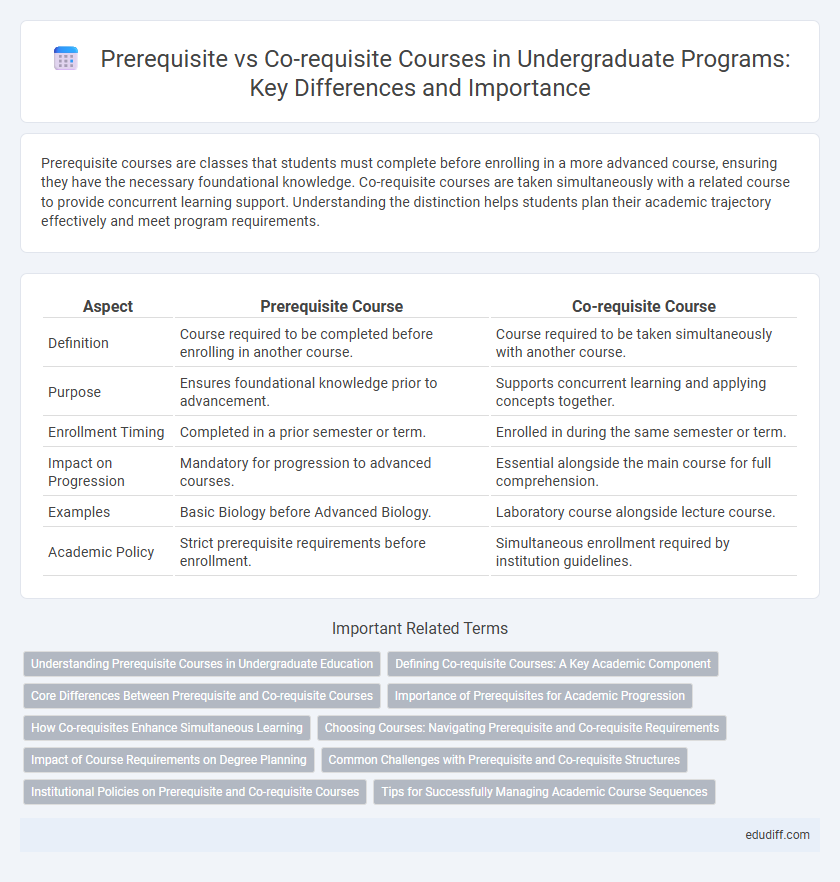Prerequisite courses are classes that students must complete before enrolling in a more advanced course, ensuring they have the necessary foundational knowledge. Co-requisite courses are taken simultaneously with a related course to provide concurrent learning support. Understanding the distinction helps students plan their academic trajectory effectively and meet program requirements.
Table of Comparison
| Aspect | Prerequisite Course | Co-requisite Course |
|---|---|---|
| Definition | Course required to be completed before enrolling in another course. | Course required to be taken simultaneously with another course. |
| Purpose | Ensures foundational knowledge prior to advancement. | Supports concurrent learning and applying concepts together. |
| Enrollment Timing | Completed in a prior semester or term. | Enrolled in during the same semester or term. |
| Impact on Progression | Mandatory for progression to advanced courses. | Essential alongside the main course for full comprehension. |
| Examples | Basic Biology before Advanced Biology. | Laboratory course alongside lecture course. |
| Academic Policy | Strict prerequisite requirements before enrollment. | Simultaneous enrollment required by institution guidelines. |
Understanding Prerequisite Courses in Undergraduate Education
Prerequisite courses in undergraduate education establish foundational knowledge essential for success in advanced classes, ensuring students have the required skills before progressing in their academic programs. These courses are mandatory to complete prior to enrolling in subsequent modules, allowing for a structured learning path that builds on previously acquired concepts. Understanding prerequisite requirements helps students plan their coursework effectively and avoid enrollment issues that could delay their degree completion.
Defining Co-requisite Courses: A Key Academic Component
Co-requisite courses are academic classes that students must enroll in simultaneously to support understanding and mastery of complex subject matter. These courses are designed to provide immediate application of concepts learned in a companion class, enhancing learning outcomes and academic performance. Defining co-requisite courses as essential components ensures streamlined progression through degree programs by integrating foundational knowledge with advanced content.
Core Differences Between Prerequisite and Co-requisite Courses
Prerequisite courses require students to complete specific classes before enrolling in advanced courses, ensuring foundational knowledge is established. In contrast, co-requisite courses must be taken simultaneously, allowing students to acquire essential skills concurrently with more complex material. This fundamental distinction impacts academic planning, progression speed, and course sequencing in undergraduate programs.
Importance of Prerequisites for Academic Progression
Prerequisite courses ensure that undergraduate students possess the foundational knowledge necessary for success in advanced subjects, thereby enhancing academic progression and minimizing failure rates. By completing prerequisites, students build essential skills and concepts that prepare them for the complexity of higher-level coursework. This structured learning pathway supports a deeper understanding and improves overall academic performance throughout the undergraduate program.
How Co-requisites Enhance Simultaneous Learning
Co-requisite courses enable students to engage with complementary subjects concurrently, reinforcing understanding through integrated content delivery. This simultaneous learning approach promotes immediate application of theoretical concepts, improving retention and academic performance. Research indicates that students enrolled in co-requisite models exhibit higher pass rates and reduced remediation compared to those in sequential prerequisite structures.
Choosing Courses: Navigating Prerequisite and Co-requisite Requirements
Choosing courses requires understanding the key difference between prerequisite and co-requisite courses to ensure proper academic progression. Prerequisite courses must be completed before enrolling in an advanced class, establishing foundational knowledge, while co-requisite courses are taken simultaneously to enhance comprehension through concurrent instruction. Effective planning using university academic advising tools and course catalogs can prevent scheduling conflicts and support timely graduation.
Impact of Course Requirements on Degree Planning
Prerequisite courses establish foundational knowledge essential for success in advanced classes, directly influencing the sequencing of a degree program and potentially extending time to graduation if not completed promptly. Co-requisite courses require simultaneous enrollment, enabling students to acquire complementary skills concurrently, which can accelerate progression through degree requirements but demands effective time management. Understanding the distinction between these course requirements allows undergraduates to optimize their academic planning, avoid scheduling conflicts, and maintain steady progress toward degree completion.
Common Challenges with Prerequisite and Co-requisite Structures
Students often face scheduling conflicts and delayed progress due to prerequisite courses that must be completed before advancing. Co-requisite courses can create cognitive overload as learners must grasp foundational and advanced material simultaneously. Both structures may contribute to increased dropout rates and extended time to degree completion if not effectively coordinated.
Institutional Policies on Prerequisite and Co-requisite Courses
Institutional policies on prerequisite and co-requisite courses establish essential academic requirements to ensure student readiness and program progression. Prerequisite courses must be completed successfully before enrolling in advanced classes, reinforcing foundational knowledge critical for academic success. Co-requisite courses require simultaneous enrollment, allowing integrated learning experiences and immediate application of concepts within the same term.
Tips for Successfully Managing Academic Course Sequences
Effectively managing academic course sequences requires recognizing that prerequisite courses provide foundational knowledge necessary before enrolling in advanced classes, while co-requisite courses must be taken simultaneously to complement each other's learning. Organizing a study schedule that balances workload and deadlines for co-requisite courses enhances comprehension and reduces stress. Prioritizing prerequisite completion ensures a smoother academic progression and better preparedness for complex topics in subsequent courses.
Prerequisite Course vs Co-requisite Course Infographic

 edudiff.com
edudiff.com